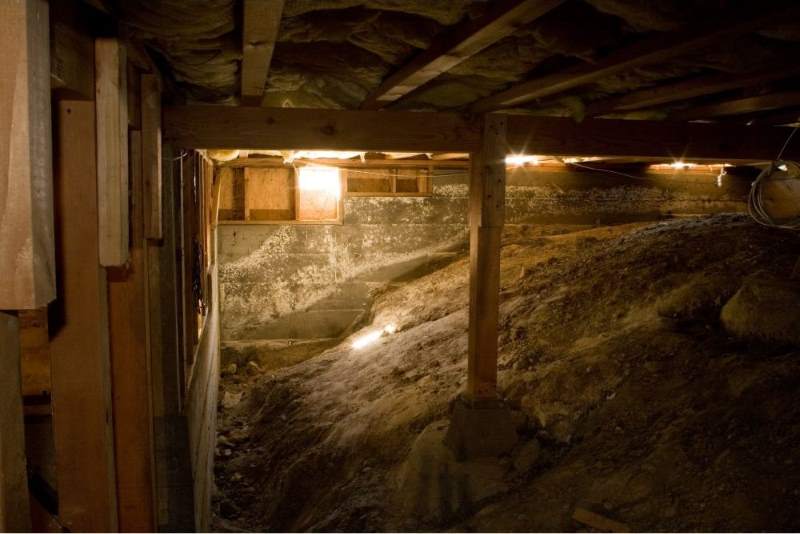Crawl space doesn’t feel like the ideal place to hang out or host guests—that is after you discover that dark, hollow hole beneath your house. You wouldn’t want to spend time in your crawl space because it’s narrow, dim, and packed with unsightly pipes, ducts, and wires. To mold, though? Unquestionably yes!
Mold is attracted to damp places like crawl spaces and attics because it tends to gather moisture, but it also likes to thrive on abundant organic waste.
The tips that follow will help you on how to prevent crawl space mold, even if most of them may have the perfect environment for mold growth.
Mold Hazards In Crawl Spaces
Unfortunately, nothing could be more from the truth than the popular belief that mold in your crawl space is “no biggie,” just because you can’t see it and nobody spends much time there.
If mold in a crawl space is not removed, there is a risk that microscopic, poisonous spores will be released and enter your house. Your family may experience a range of health issues as a result of breathing in these spores, including:
- Anxiety and depression
- Asthma
- Breathing issues
- Headaches
- Infection on the bones
- Mental health problems
- Persistent sinusitis
- Rashes on the skin
- Red, scratchy eyes
- Stuffy nose
- Weakness and discomfort in joints
- Wheezing and coughing
- Prolonged fatigue
You should know how to prevent crawl space mold because mold may worsen these symptoms for those with weakened immune systems.
Common Indications Of Mold In Your Crawl Space
Discoloration On Baseboards, Floors, Or Walls
Mold-damaged surfaces in your house can develop discolored and/or fuzzy-looking. Mold comes in a wide variety of types and colors, including yellow, white, black, and brown. It’s a good idea to do a mold test if you see discoloration on the surfaces of your house.
Experiencing Allergies
Many adverse health effects can arise from having mold in your crawl space, particularly if the exposure is prolonged. Several uncomfortable, persistent symptoms might result from extremely frequent mold allergies. Some individuals are more sensitive than others, such as those with autoimmune diseases, respiratory issues, or a family history of allergies.
Typical mold allergy symptoms include:
- Coughing
- Headaches
- Itchy nose, throat, and eyes
- Scaly or dry skin
- Sore throat
- Sneezing
- Stuffy nose
Musty Smell
One of the most typical indicators of mold growth is a musty smell, especially if it keeps getting worse over time. Microbial volatile organic compounds, which are released by growing mold, frequently give off an earthy or musty smell. A musty smell in your house, particularly in your crawl space, could indicate that you have a mold infestation.
Pests Infestation
Since many of these pests and bugs feed on decaying matter or the mold itself, mold attracts a lot of common bugs and pests like booklice, cockroaches, fungus gnats, and crickets. A rise in bug activity near your crawl area could be a sign that mold is developing there.
Sagging Floors
Paper, wood, and other organic materials are ideal substrates for mold. This may lead to deterioration, warping, and sagging of the surfaces of your house. Mold could be the cause of your floors’ uneven texture or sagging implications.
Water Damage
It is a good idea to keep checking out for mold if your house has recently experienced water damage. Unquestionably, water damage from a flood or leak raises the moisture content in your house, which helps mold grow. For this reason, it’s wise to act proactively to stop mold growth following water damage.
Withering Beams
The structural supports in your house could begin to weaken as a result of excessive dampness. Mold may be to blame if the wooden beams in your crawl space are beginning to rot, break down, or take on new forms.
Ways On How To Prevent Crawl Space Mold
- Make sure there are no gaps or cracks in the foundation walls that could allow water to enter.
- When it rains, make sure that the gutters and downspouts are directed at least 6 feet away from the home. If not, water may collect close to your house and possibly seep into your crawl space.
- Make sure there is enough airflow. For every 150 square feet of crawl space area, there should be one square foot of ventilation at the absolute least. Well-ventilated crawl areas are something we enjoy.
- Snug up against the subfloor in ventilated crawl spaces. Tightly secure the insulation with mechanical fasteners. Don’t just jam insulation between joists in the subfloor and hope it remains there. If there are no fasteners, it will probably fall out eventually.
- Ensure that the insulation you currently have is not missing or drooping, as these two things may indicate a water issue.
- Ensure that a vapor barrier made of plastic sheeting extends up a few inches across the foundation walls and covers the entire dirt crawl area. There should be lots of overlap between the layers of sheeting and no standing water on the sheeting. Applying plastic sheeting appropriately will help your crawl space function as a necessary vapor barrier.
- Keep an eye out for leaks near plumbing and HVAC ducts.
- Vents from dryers ought to go out of the house outside rather than into the crawl space.
- Check the ceiling of your crawl space for any holes or cracks.
Suspect For Mold Growth On Your Crawl Space?
Are you unclear about what to do next because you think mold has gotten into your crawl space? Keep mold and uncertainty out of your house. Take immediate action by scheduling a crawl space assessment with a trustworthy professional mold remover. Find out the kind of mold that is hiding beneath your house and find the best ways to get rid of it so that your house is safer and healthier. They will also advise you on how to prevent crawl space mold.

